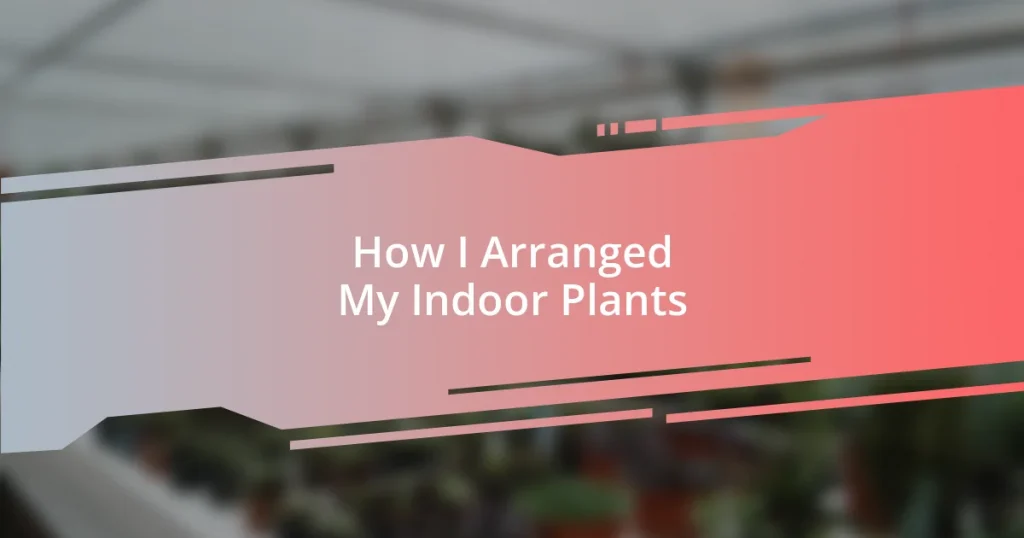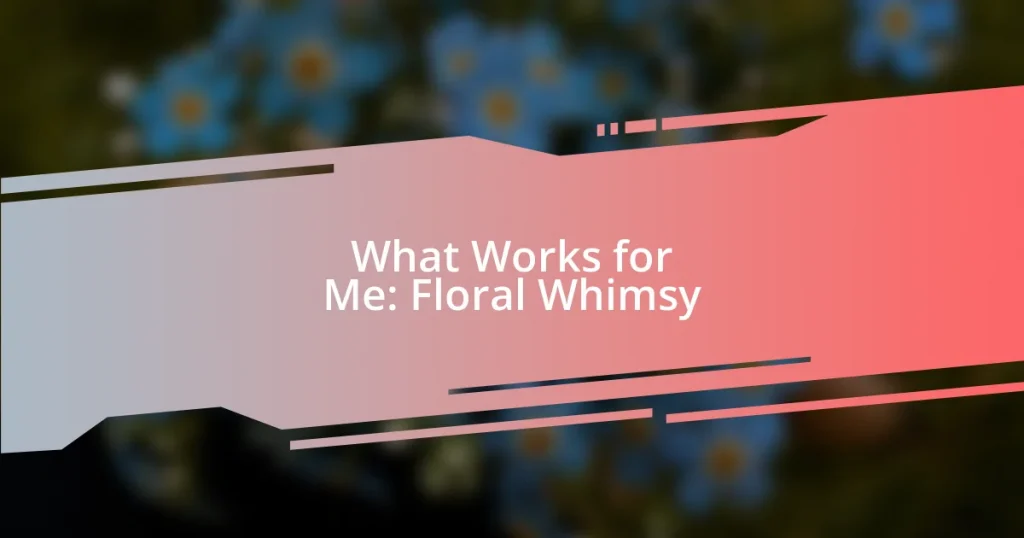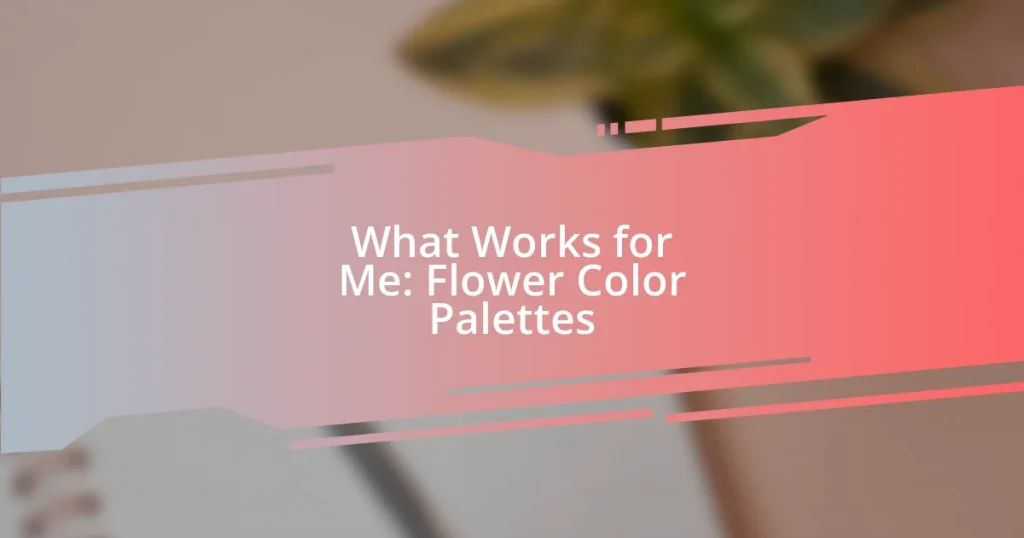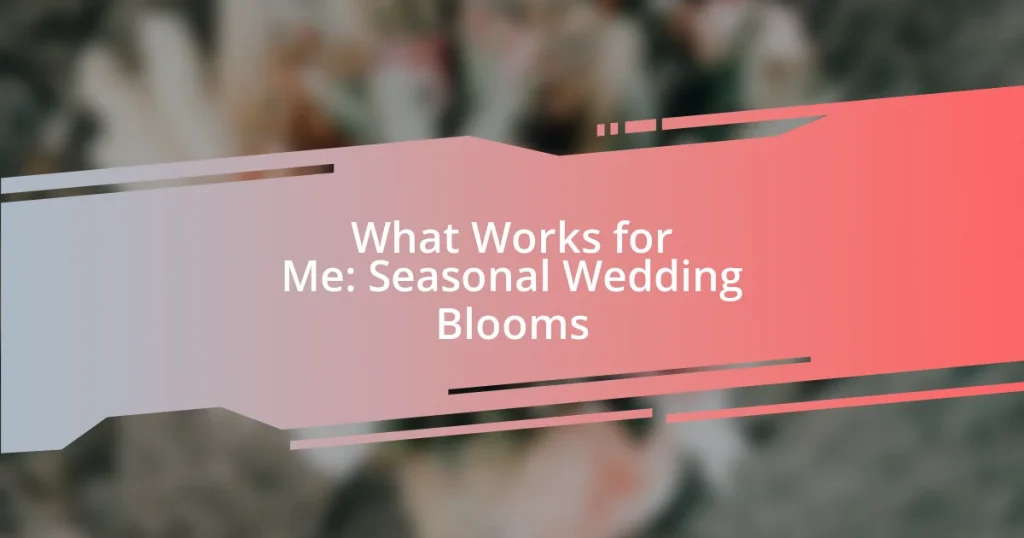Key takeaways:
- Understand light conditions and plant needs to create a thriving indoor garden, categorizing plants based on their specific lighting requirements.
- Choose appropriate containers that ensure proper drainage and suit the plant’s growth, balancing aesthetics with functionality.
- Maintain plant health by paying attention to individual watering and feeding needs, adjusting care with seasonal changes to optimize their environment.
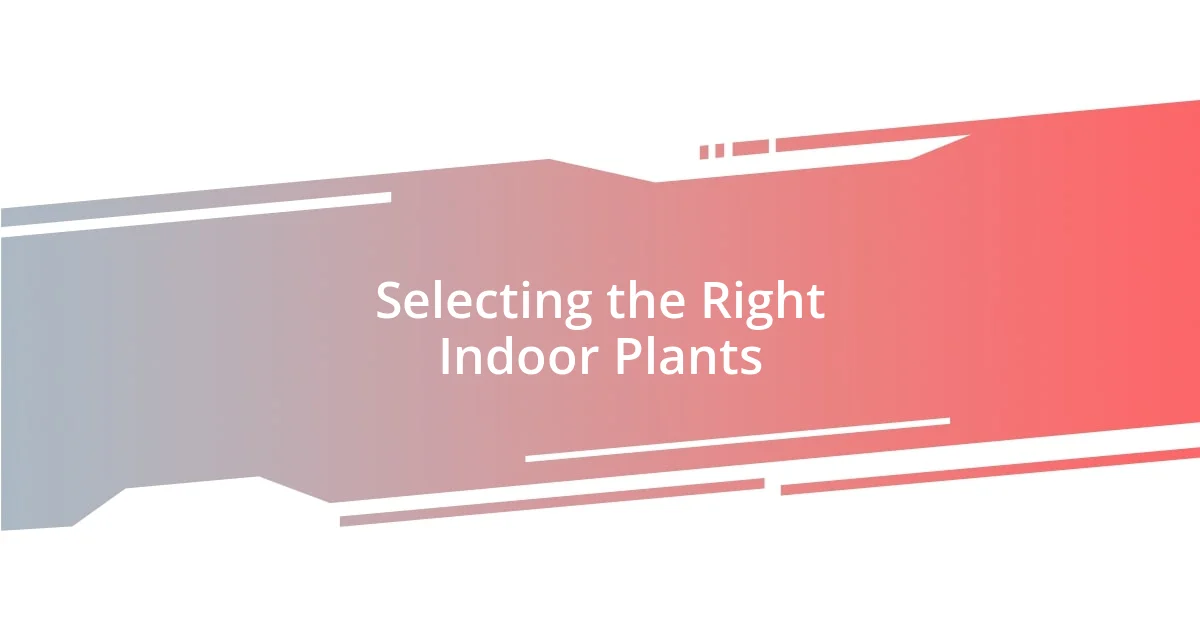
Selecting the Right Indoor Plants
When I first ventured into the world of indoor plants, I was overwhelmed by the choices available. I remember standing in a local nursery, captivated by the vibrant colors and textures, but unsure how to choose the right ones for my home. Have you ever felt that same sense of wonder mixed with uncertainty? It’s essential to consider not just the aesthetics but also the specific care requirements of each plant.
One of the key factors in selecting indoor plants is understanding the light conditions in your space. For instance, I learned the hard way that my beautiful fern thrived best in indirect sunlight, while the succulents I adored needed bright, direct light. This realization led me to categorize my plants based on their light needs, transforming my indoor garden into a beautiful, harmonious space that flourished because I listened to the plants rather than just my initial whims.
Another crucial aspect is considering your lifestyle and commitment level. If you travel often or have a busy schedule, low-maintenance plants like snake plants or pothos are fantastic choices. I recall the moment I repotted my first snake plant, thrilled by its resilience and ability to forgive the occasional missed watering. Isn’t it comforting to know that some plants can adapt as much as we do?

Understanding Light Requirements
Understanding the light requirements of indoor plants is essential for their health and longevity. I still vividly remember the first time I placed a gorgeous peace lily in a poorly lit corner of my living room. Its slow decline was a wake-up call, teaching me that even the prettiest plants need the right environment to thrive. This experience pushed me to closely observe how natural light enters each room; it’s fascinating how different spaces can transform throughout the day.
To make it simpler, here’s a quick guide to common light requirements for indoor plants:
- Direct sunlight: Ideal for succulents and cacti; they typically need around 6 hours of sunlight daily.
- Bright, indirect light: Great for plants like snake plants and rubber plants; they thrive in well-lit areas but without direct sun.
- Low light: Perfect for philodendrons and pothos; these can flourish in dimmer corners, requiring minimal sunlight.
- Filtered light: Needs soft, diffused light that mimics shade; plants like ferns and peace lilies appreciate this type of setting.
Understanding these nuances has made a significant difference in how I care for my indoor garden. Each plant’s unique needs remind me just how rewarding it is to nurture them in the right conditions.

Choosing Appropriate Containers
Choosing the right containers for your plants can be just as important as selecting the plants themselves. When I first began my indoor gardening adventure, I used traditional terra cotta pots for everything. While they look charming, I quickly discovered the importance of drainage. Overwatering my beautiful monstera led to root rot, something I never want to experience again! Now, I always opt for pots with drainage holes and consider materials that contribute to my plants’ overall well-being.
I often compare different materials to see how they affect plant growth. For example, ceramic pots can retain moisture better than metal containers, which tend to heat up quickly. I’ve found that my succulents are much happier in ceramic pots, as they maintain a more stable environment for their roots. Have you thought about what makes your plants comfortable? I never would have imagined that a material could change everything, but it truly does!
Lastly, decorative containers can really enhance your indoor space. I enjoy the process of selecting pots that reflect my personal style. However, functionality should never be compromised for aesthetics. My favorite combo? A beautiful ceramic pot with proper drainage, paired with a colorful saucer. This not only looks lovely but ensures my plants thrive. It’s a delightful balance between beauty and practicality that keeps my indoor garden flourishing.
| Container Type | Pros |
|---|---|
| Terra Cotta | Good air circulation; ideal for drought-tolerant plants |
| Ceramic | Attractive and retains moisture well |
| Plastic | Lightweight; durable and inexpensive |
| Metal | Modern look; can reflect heat |
| Concrete | Heavy; excellent at stabilizing temperature |
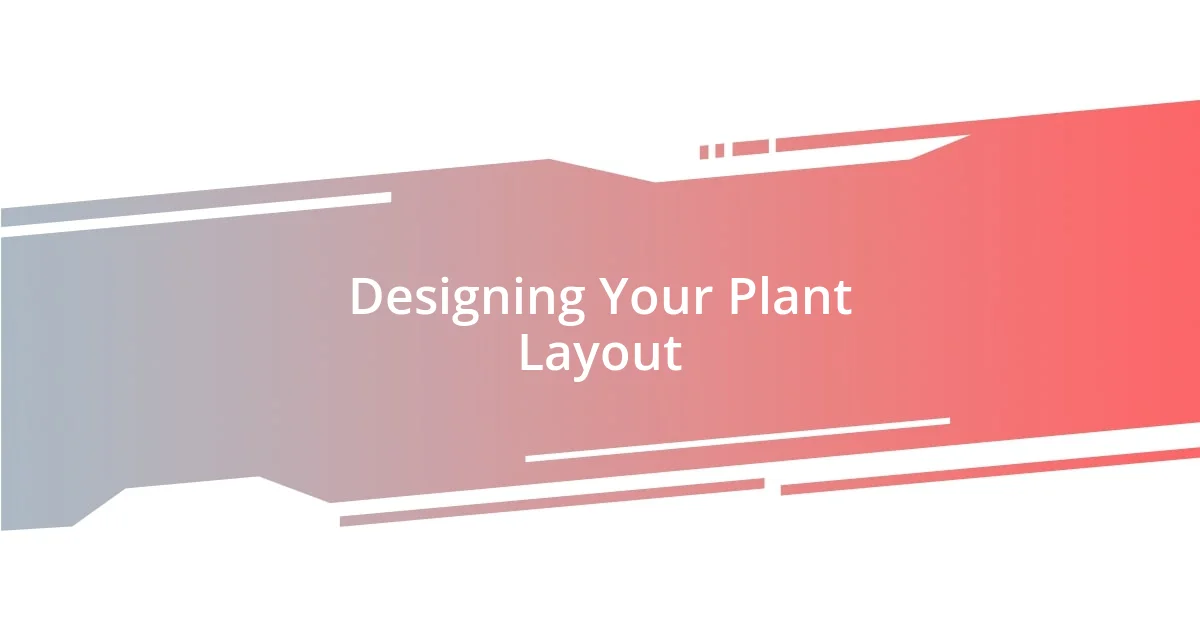
Designing Your Plant Layout
Designing your plant layout really hinges on understanding how to balance aesthetics with functionality. When I first began arranging my indoor plants, I was focused solely on creating a beautiful display. However, that approach often left my plants fighting for light or crammed into spaces where they simply couldn’t thrive. Now, I prioritize the health and comfort of each plant, allowing them room to breathe and grow.
I like to think of my plant arrangements as creating a living tapestry. For instance, having taller plants like a dracaena at the back and smaller ones like herbs in the front creates a visually appealing layer. It also allows each plant to receive adequate light without overshadowing one another. Have you ever looked at your plants and felt they were almost competing for attention? That’s exactly how I used to feel, but now I strategically place them in a way that highlights their unique features while ensuring they all get a fair share of sunlight.
Don’t underestimate the power of grouping plants by their needs! Initially, I mixed all my plants together, which resulted in some unhappy greens. Now, I keep my humidity-loving ferns together in a cozy corner by a window, while my succulents bask in the more arid sun that streams through another part of my home. Each time I make adjustments, it feels like orchestrating a symphony where every plant plays its role in harmony, and honestly, witnessing them thrive is one of the greatest joys in my indoor gardening journey.

Arranging Plants for Aesthetic Appeal
Arranging plants for aesthetic appeal goes beyond just placing them in a nice pot. I remember the first time I saw a friend’s home filled with plants in varying heights and colors—it was like stepping into a lush jungle. That aesthetic drew me in, and I knew I wanted that same vibrancy in my own space. I usually opt for a mix of cascading plants, like pothos, on hanging shelves, paired with upright ones, like snake plants, to create depth and interest throughout the room.
Color contrast can work wonders in enhancing the beauty of your indoor garden. I’ve found that arranging vibrant flowers like peace lilies next to deep green foliage instantly uplift my mood. When I play with color, it feels almost like painting a canvas, where each hue contributes to the overall vibe. Have you ever thought about how colors can change the energy of your space? I often experiment with different combinations until one arrangement feels just right—like it’s singing to the atmosphere around me.
Texture is another element I absolutely adore incorporating into my plant displays. I often mix plants with smooth leaves, like ZZ plants, alongside those with fuzzy textures, like lamb’s ear. This contrast not only pleases the eye but adds an inviting tactile element to my indoor jungle. I can’t help but touch the leaves as I walk by; it’s as if each plant invites me to engage with it. How do you feel when you see a diverse range of textures? For me, it creates a comforting sensation—it’s about bringing nature’s variety indoors and celebrating it in my living space.

Maintaining Plant Health and Care
To maintain healthy indoor plants, I’ve found that paying attention to their specific watering needs is essential. For example, I used to water my succulents the same way I watered my ferns, which only resulted in droopy leaves and sad plants. It’s fascinating how each species has its own requirements; succulents thrive on dryness, while ferns love a good misting. Have you ever noticed how your plants react differently to the same care? It really highlights the importance of getting to know each one personally.
Feeding is another aspect where I learned some hard lessons. I once bought a big bag of all-purpose fertilizer, thinking it would work for everything. Unfortunately, my orchids didn’t take kindly to it, and I was left with disheartened blooms. Now, I use fertilizers that cater specifically to the needs of various plants. It’s a little effort upfront, but seeing healthier leaves and blooms makes it worth it. What’s your fertilizer strategy? Customizing care can make a world of difference.
Lastly, I can’t stress enough how lighting affects plant health. I initially placed my snake plant in the darkest corner, hoping it would adapt. To my surprise, it started leaning toward the nearest light source, almost begging for attention! Now, I’m more intentional about sunlight exposure, ensuring each plant is placed where it can thrive. I’ve even experimented with grow lights for my more light-hungry plants, which has been a revelation. Have you thought about how a simple change in placement could revive a struggling plant? It’s all part of the learning curve in this rewarding gardening adventure.

Tips for Seasonal Adjustments
When the seasons shift, I find it’s vital to reassess how my plants are arranged. For instance, during fall and winter, I often bring my tropical plants closer to the window to soak up every bit of sunlight. Do you notice how the natural light changes with the seasons? I remember being surprised at how much brighter my room felt just by moving my plants—a small adjustment that made a huge impact on their health and my mood.
As spring arrives, I like to take advantage of the warmer temperatures by introducing outdoor time for my indoor plants. I used to think they’d make it through spring and summer without a little fresh air. However, the first time I set my peace lily on the patio, I instantly noticed its leaves perk up, almost as if it was saying, “Thank you!” Are your plants getting enough variety in their environments? I now see seasonal adjustments as a chance to invigorate my indoor garden, creating a dynamic space that evolves just like nature.
And then there’s the matter of humidity. In winter, when the air gets dry, I often group my humidity-loving plants together, creating a mini rainforest effect. It’s like a little trick I learned after watching my ferns droop in despair. Have you ever tried clustering plants? This simple strategy has transformed my space into a cozy oasis and has certainly kept my plants happier, reinforcing just how interconnected they are with their surroundings.










